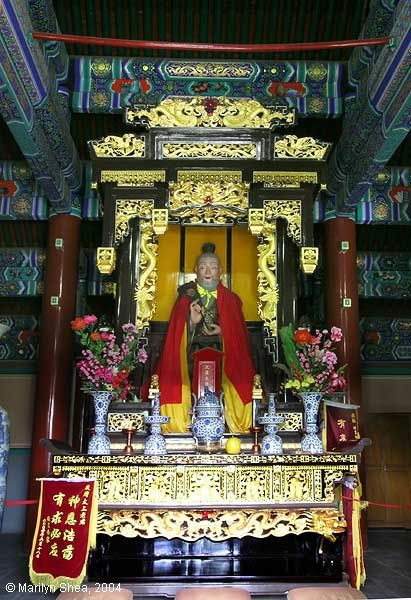 |
| The god on the right of the San Qing Temple is Taiqing Daode 太清道德天尊 (Tàiqīng Dàodé Tiānzūn), or as most people know him, Laozi.
Daode 道德 (Dàodé) means "way of virtue". The teachings of Laozi 老子 (Lǎozǐ) both teach virtue and come from his virtue. There isn't much known about Laozi as historical fact. He lived somewhere between the 6th and 4th centuries BC. There are so many myths surrounding him and few written records that it is anyone's guess. Sima Qian wrote a history around 100 BC in which he placed Laozi in the time of Confucius (551-479 BC) or slightly earlier. Traditionally, the Dao De Jing 道德经 (Dàodéjīng), the primary Daoist text, was written by Laozi. (In English, it is often spelt Tao Te Jing). The Dao is more than the Way, it is the organization of things, the pattern, the spirit, and the balance. It does not exist but is everywhere. During the early days of Daoism, Laozi was simply considered a great philosopher and teacher. His philosophy was studied and certain practices followed to lead toward greater understanding of self and the universe. It was a philosophy of retreat from the world of distractions. Gradually, probably due to the influence of Buddhism, an import from the west, Daoism took on religious significance and elaborate practices. The same thing happened to Confucianism, although in that case with much more deliberate intent. It was during the Han Dynasty that a prime minister recommended to his Emperor that making Confucianism a religion and Confucius a god would stabilize the populace. Daoism developed more gradually and sought to incorporate belief systems already in play. They adopted gods from ancient religious practices from many different regions of China. Laozi became one of the primary gods, and he was seen, not simply as a man, but as a god who had come to impart qi and the Dao throughout history. He was seen as the advisor to the early mythical kings of China. These kings invented agriculture, writing, the ability to live together, weaving, and many other great cultural inventions, all with the advice of Laozi. Laozi was used to explain the great events of history. He was seen as the advisor to kings and sometimes as taking the form of the king himself. Over the centuries many different traditions of Daoism came and went. We explored the Quanzhen tradition earlier in these pages. Each of them added to the pantheon of gods and to the interpretation of the Dao De Jing with scripture, poems, and guiding principles. One of the early traditions, the Lingbao tradition (灵宝 Língbǎo) foreshadowed the Quanzhen tradition by including Buddhist principles and practices. Baiyun Guan includes only some of the pantheon of deities that have become part of Daoism. If you visit other Daoist centers or temples you will find many others represented, but the San Qing will always be there. |
http://hua.umf.maine.edu/China/beijing2.html
Last
update: October 2009
© Marilyn Shea, 2009